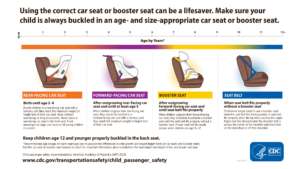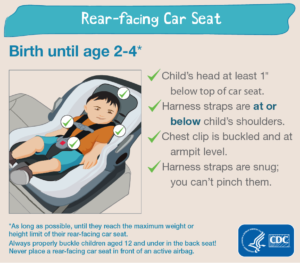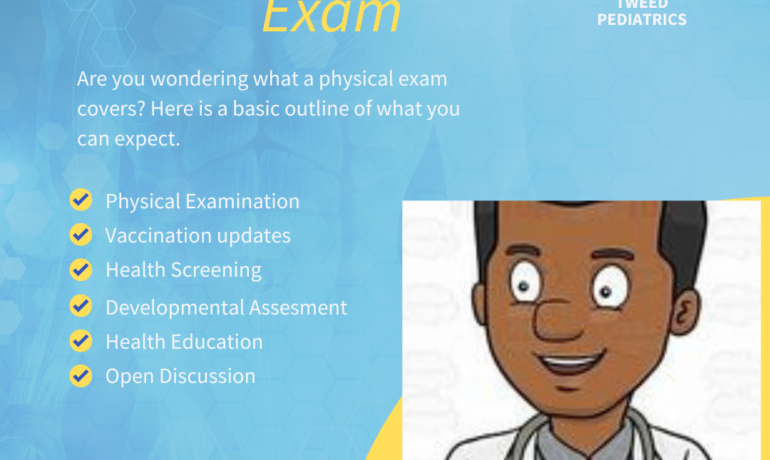Did you know…. That car seats reduce injury from car crashes by 71-82% compared to seat belt use alone! Here is a break down by the CDC for appropriate car seat use:
Know the Stages
Make sure children are properly buckled in a car seat, booster seat, or seat belt—whichever is appropriate for their age, height, and weight.
- Use a rear-facing car seat from birth until age 2–4.
- Infants and toddlers should be buckled in a rear-facing car seat with a harness, in the back seat, until they reach the maximum weight or height limit of their car seat. This offers the best possible protection.
- Check the car seat manual and labels on the car seat for weight and height limits.
- Never place a rear-facing car seat in the front seat. Front passenger air bags can injure or kill young children in a crash.
- After outgrowing the rear-facing car seat, use a forward-facing car seat until at least age 5.
- When children outgrow their rear-facing car seats, they should be buckled in a forward-facing car seat with a harness, in the back seat. They should stay in the forward-facing car seat until they reach the maximum weight or height limit of this seat.
- Check the car seat manual and labels on the car seat for weight and height limits.
- After outgrowing the forward-facing car seat, use a booster seat until the seat belt fits properly.
- When children outgrow their forward-facing car seat, they should be buckled in a belt-positioning booster seat with a seat belt, in the back seat, until the seat belt fits properly without a booster seat. A seat belt fits properly when the lap belt is across the upper thighs (not the stomach) and the shoulder belt is across the center of the shoulder and chest (not on the neck/face or off the shoulder). This typically does not occur until children are age 9–12.
- When the seat belt fits properly without a booster seat, use a seat belt on every trip.
- Children no longer need to use a booster seat when the seat belt fits them properly. A seat belt fits properly when the lap belt is across the upper thighs (not the stomach) and the shoulder belt is across the center of the shoulder and chest (not on the neck/face or off the shoulder).
- Proper seat belt fit typically does not occur until children are age 9–12. Seat belt fit can vary by vehicle so check fit in all vehicles to make sure the child no longer needs to use a booster seat. It could be that a child might need a booster seat in one vehicle but not another.
- Keep children properly buckled in the back seat through age 12 for the best possible protection.
Below is a link that answers most questions about car seats.
https://www.cdc.gov/injury/features/child-passenger-safety/index.html




